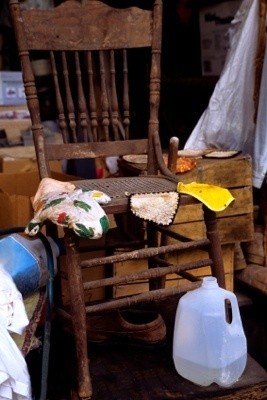There are antique collectors, those who preserve and cherish the originality of an older piece. Then, there are those who enjoy old things. This group is the group who likes the look of antiques but isn't interested in preserving original paint but rather incorporating the old piece into today's world. These are the people who can snatch up great bargains that the others have left behind. If you're not afraid of refinishing, repairing, or re-purposing battered antiques, then you have a gold mine awaiting you at the next swap meet.
There are many pieces of antique furniture that suffered through the 1970's and 1980's, a time when old pieces were painted in stylish modern colors. Now, these pieces are crying for new life but are too gaudy to attract the attention of true collectors. Enter the average person.
Furniture can be stripped which can be difficult. If you're unsure of what's under the paint or you're not interested in hours of stripping and sanding, try repainting it with a more pleasurable palate. I have an old whitewashed mission style dresser that I've repainted a neutral tan. Then, with acrylic paints, I added some folk art painting to each drawer, coating it with a clear coat protector afterward. It's no longer the original style of its creation, but it is a pleasing and sturdy piece that was rescued from the curbside pickup.
Old iron pieces cost less when they look worse. Brush the loose rust off with a wire brush and repaint them with black Rustoleum paint. They look like "new" wrought iron. I've repainted chicken feeders with silver Rustoleum as well as large milk cans and other outdoor accessories.
Another visually appealing fix is found in the craft stores. Gold leafing is a product that when rubbed onto a surface creates a "new" metallic coat. It dries quickly and can be removed if you change your mind about the look of it. By rubbing it onto a picture frame or pewter item that lost its silver plating, the item gets a new metallic look. It's not an original metallic coat, but when you find $1 pewter candle sticks with great architectural design, it doesn't hurt to add another $3 worth of plating to rejuvenate the unsalvageable.
Strong wooden furniture is too pricey in the stores, but it can be found lurking in flea markets and garage sales. Gravitate towards the broken pieces. If a leg is broken, consider replacing all four legs with new spindles made out of railing posts sold at home improvement stores. Metal ceiling tins sold at the same stores can replace broken panels in cabinet doors or line the tops of warped dressers and end tables. Find a local glass cutter and employ him/her to cut new pieces for old picture frames and cabinet doors.
Be creative in your repairs. Can you piece two damaged items together to create one good one? Could modern elements be added to replace broken old pieces? I've found that a good clay epoxy is crucial for repairs. I can mold the clay to fix broken plaster picture frames or carved wooden details that have been cracked or damaged.
If all else fails, think of what your item could be. There is no better entertainment unit or dining room buffet than a large dresser. Remove a drawer of the dresser (or better yet, salvage one with a damaged drawer) and cut a board to serve as a shelf instead. Old window sashes can become collage photo frames, and anything can become a planter.
Remember that if you find an antique item in good condition, don't try any of these options. Enjoy its natural beauty or sell it to someone who will. Yet, for those sad old items that have been left in leaky barns, broken, or painted avocado green, give them a new lease on life and try some creative finishing options.

Add your voice! Click below to comment. ThriftyFun is powered by your wisdom!